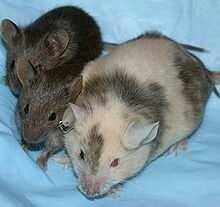Chimera (genetics)

genetic chimerism or chimera (also spelled chimaera) is a single organism composed of cells with distinct genotypes. In animals, this means an individual derived from two or more zygotes, which can include possessing blood cells of different blood types, subtle variations in form (phenotype), and if the zygotes were of differing sexes then even the possession of both female and male sex organs[1] (this is just one of many different ways that may result in intersexuality). Animal chimeras are produced by the merger of multiple fertilized eggs. In plant chimeras, however, the distinct types of tissue may originate from the same zygote, and the difference is often due to mutation during ordinary cell division. Normally, genetic chimerism is not visible on casual inspection; however, it has been detected in the course of proving parentage.[2]
Another way that chimerism can occur in animals is by organ transplantation, giving one individual tissues that developed from a different genome. For example, transplantation of bone marrow (an organ often not thought of as being such) often determines the recipient's ensuing blood type.
Nice photography